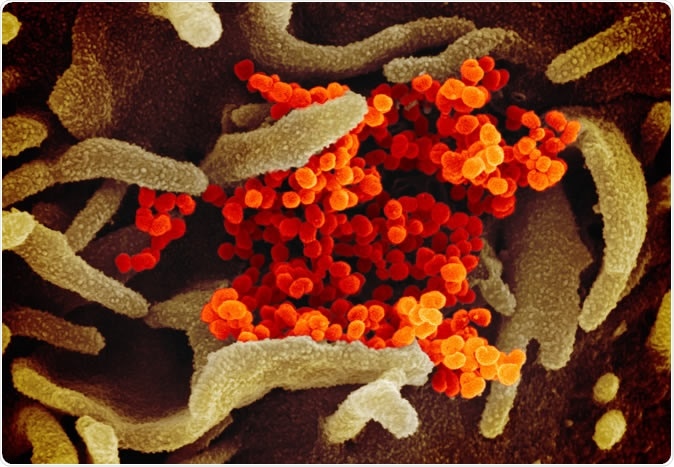As COVID-19 (coronavirus) spreads across the globe, scientists have found the virus can persist in the air for hours and on surfaces for days.
A team of scientists from the National Institute of Allergy and Infectious Diseases (NIAID), which is part of the U.S. National Institutes of Health in the U.S., analyzed the aerosol and surface stability of the severe acute respiratory syndrome coronavirus 2 (SARS-CoV-2), compared to the virus that has caused SARS back in 2003, the SARS-CoV-1.
The study, published in The New England Journal of Medicine, shows the virus that causes COVID-2019 is stable for three hours in the air, up to four hours on copper, up to 24 hours on cardboard, and up to two to three days on stainless steel, and plastic. The study results shed light on the stability of the deadly virus, which has sickened 242,191 people and killed 9,843 people worldwide.

Novel Coronavirus SARS-CoV-2 This scanning electron microscope image shows SARS-CoV-2 (orange)—also known as 2019-nCoV, the virus that causes COVID-19—isolated from a patient in the U.S., emerging from the surface of cells (green) cultured in the lab. Credit: NIAID-RML
Testing the stability of the virus
The researchers attempted to mimic the virus being deposited from an infected person onto surfaces at home and in hospitals. Usually, people transmit the virus to surfaces or into the air by coughing, sneezing, and touching surfaces. The common surfaces people touch include light switches, doorknobs, tables, sinks, elevator buttons, and their cellphones.
When they already determined surfaces often touched by humans, they noted how long the virus remained infectious on these surfaces.
“If the viability of the two coronaviruses is similar, why is SARS-CoV-2 resulting in more cases? Emerging evidence suggests that people infected with SARS-CoV-2 might be spreading the virus without recognizing or before recognizing symptoms,” the authors wrote in the paper.
“This would make disease control measures that were effective against SARS-CoV-1 less effective against its successor,” they said.
In the study, the researchers used experimental conditions using two viruses, the one that caused SARS and the novel coronavirus, which first emerged in a seafood market in Wuhan City, Hubei Province. China, the most shaken region with over 80,000 confirmed cases and more than 3,000 deaths. The environmental conditions include aerosols, stainless steel, plastic, cardboard, and copper.
“We found that the stability of SARS-CoV-2 was similar to that of SARS-CoV-1 under the experimental circumstances tested. This indicates that differences in the epidemiologic characteristics of these viruses probably arise from other factors, including high viral loads in the upper respiratory tract and the potential for persons infected with SARS-CoV-2 to shed and transmit the virus while asymptomatic,” the team concluded.
How is the coronavirus transmitted?
The U.S. Centers for Disease Control and Prevention (CDC) reports that the novel coronavirus is transmitted from one person to another when they come in close contact, within about 6 feet of one another. Scientists also noted that the transmission is akin to how influenza is spread through respiratory droplets when a sick person coughs or sneezes.
The estimated incubation period is between two and 14 days, while most people develop the symptoms by 4 to 5 days after exposure. Health officials also noted that people could transmit the virus even if they have no symptoms, making contact tracing and virus spread control more difficult and tedious.
The virus can also be transmitted by touching contaminated surfaces and then touching the face, particularly the nose, eyes, or mouth. The World Health Organization (WHO) estimates that an infected person can transmit the virus to 1.4 to 2.5 people.
In the current study, the scientists highlighted additional observations. They found that the viability of the two coronaviruses is similar, but the SARS-CoV-2 is causing more infections. Evidence shows that people can transmit the virus without them knowing it because they feel perfectly well. Asymptomatic individuals do not recognize the illness because they do not have symptoms, making disease control measures that were effective in the SARS outbreak in 2003, not effective in the current outbreak.
Further, the team also found that the current outbreak, caused by the SARS-CoV-2, is occurring in the community setting rather than healthcare settings such as hospitals. However, the new coronavirus can also spread in hospitals since the virus is stable in the air for hours and surfaces for days.
How to disinfect surfaces?
The new study findings strengthen the already imposed guidelines and restrictions to curb the spread of COVID-19. To limit the virus spread, it is essential to avoid close contact with others who are sick, avoid touching the eyes, nose, and mouth, covering when sneezing or coughing and disposing the tissue properly, staying home when sick, self-isolating for those who are vulnerable, and cleaning or disinfecting frequently touched objects and surfaces, such as doorknobs, tables, and light switches.
The CDC recommends that people should routinely disinfect frequently touched surfaces, including desks, toilets, faucets, tables, doorknobs, and handles, with household cleaners and EPA-registered disinfectants.
Wear disposable gloves when disinfecting surfaces, and these should be discarded every after use. For disinfection, people can use 70 percent alcohol and diluted household bleach solutions. Dilute five tablespoons of bleach per gallon of water or four teaspoons bleach per quart of water. Never dilute bleach with ammonia or other cleansers.
Regularly washing the hands is the most important means to fight the novel coronavirus. Wash the hands every after touching surfaces, after using the restroom, after blowing the nose, before eating or preparing food, before and after providing care for infants or another person who needs assistance.